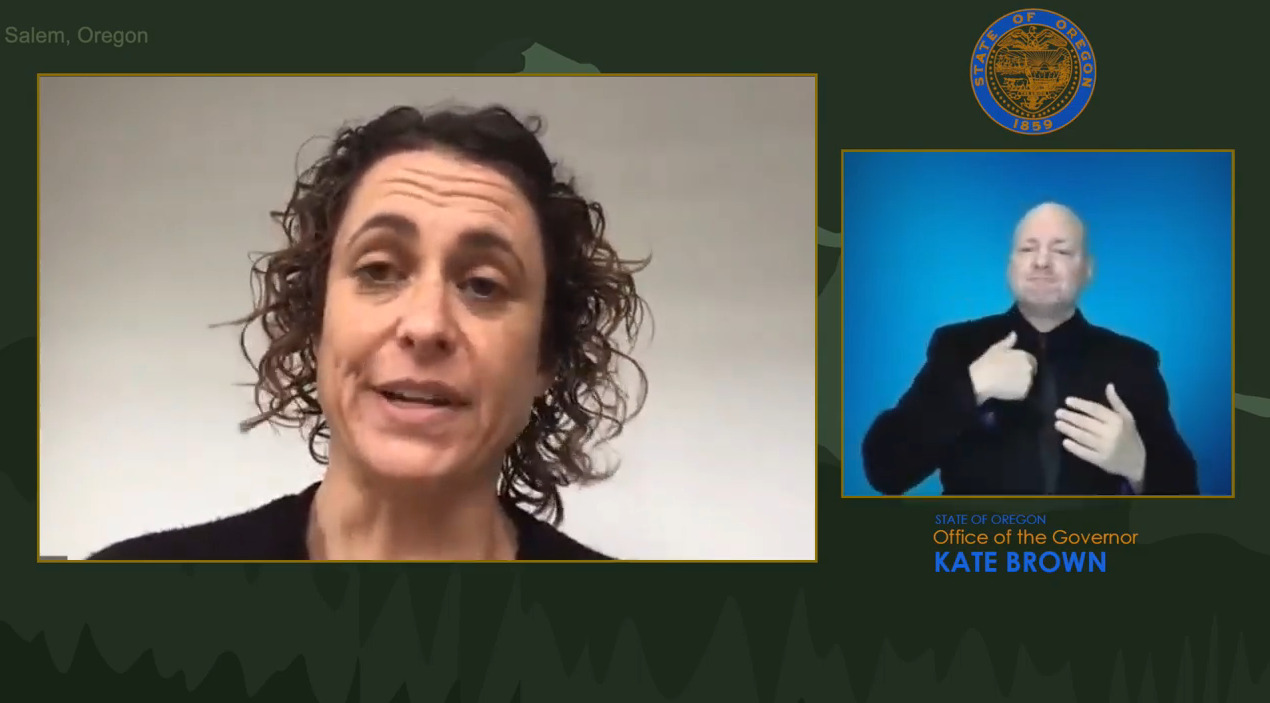Formerly active, healthy Portland mother, 40, can barely walk around the block: ”This is an unpredictable and terrifying disease.’
SALEM , Ore. (KTVZ) – Gov. Kate Brown laid out Friday the details of plans to quickly distribute 140,000 doses of two COVID-19 vaccines expected in the state by the end of December – and an extensive campaign that will urge Oregonians to get the shots officials assure are safe and effective.
But during the same online news conference a Portland woman who was health and active before COVID-19 hit drove the point home in more tragic, dramatic fashion, a so-called “long-hauler” with numerous serious lingering health impacts who pleaded for Oregonians to come together and tackle the virus in ways many are very weary of following.
“I know many people, especially younger people, feel that this virus is not a threat to them, or that the risk of catching it is low,” Darrah Isaacson said. “Many think it’s not worth the precautions – the masking, the distancing, the social isolation that this has caused. Some people think that this is just like the flu.”
“I can tell you from personal, and horrible experience, that that way of thinking is extremely dangerous,” she said. “This is an unpredictable and terrifying disease.”
“I’m still alive, thankfully, but my life has been turned completely upside down,” said Isaacson, who when she turned 40 could not have her mom’s birthday cheesecake because she was in bed with a racking cough, severe body aches, unrelenting headache and fever – in such poor condition that she remembers little of those days.
“Little did I know I’d still be sick 10 months later, and with more symptoms,” Isaacson said. “I’m a COVID ‘long-hauler,’ and there are thousands of us across the country dealing with debilitating, long-term, possibly life-long symptoms due to COVID. Many were very active, healthy, with no underlying health conditions.”
Isaacson said she and her husband and 5-year-old daughter were a very active family, and “I can barely walk around the block now.”
“I realize most of us don’t like to be told what to do, especially when we believe we’re not part of the problem,” she said. “This is not the time for blame or arguments. This is the time to make some sacrifices, so we can come together and keep this virus from harming any more families like mine.”
Brown said Oregon expects 140,000 doses of the Pfizer and Moderna by the end of December (which would be enough for 70,000 people, since there are two doses), and noted that Oregon has been a leader in rapid statewide distribution of vaccines against preventable diseases, from the flue to the measles.
“We have policies and programs in place to vaccinate all of Oregonian, and we are pulling every one of those levers,” Brown said, including an extensive public outreach campaign, which she called “the vaccine campaign of our lifetime, distributing to communities as quickly as possible, prioritizing among the hardest hit and most at risk.”
Brown said hospitals will be the primary sites for the first group of vaccine recipients, and a “cold chain network” has been set up for the ultra-cold space needed for the Pfizer vaccine, which must be stored at minus-94 degrees.
“We estimate about 100,000 Oregonians will get their first vaccine doses by the end of the year,” the governor said.
With some 300,000 health care workers in the state, the first priority will be staff at hospitals and other inpatient facilities with direct patient contact, especially with those with COVID-19.
“That will include people in vital roles such as housekeeping and food services,” Brown said, “then expect to outpatient and other settings,” including those in behavior health treatment and those meeting the needs of people with intellectual and developmental disabilities.”
Surveys have shown only four in 10 Oregonians said they are certain to get the vaccines, “so we certainly have our work cut out for us,” Brown said, especially in an environment where the pandemic response has been so politicized.
In the meantime, she said, it’s important to continue to “remind Oregonians to keep up their guard” by wearing masks, practicing social distancing and limiting get-togethers “until we achieve community immunity.”
“The harsh reality is that I’m asking everyone to step up for a few more months,” Brown said. “It might be most of the year, we don’t know yet. But there is some light at the end of the tunnel, and I am hoping that we can celebrate next year’s holidays with our families and friends.”
And once again, as Congress keeps debating COVID-19 releif packages, Brown said the state needs federal support “to keep Oregonians in our homes and businesses across the state operating.”
“It’s absolutely true we’re all in the same storm, but we are not all in the same boat,” she said.
Oregon needs to vaccinate about 10,000 people a day to get to 3 million, or three-quarters of Oregonians. “That’s the scale we need to achieve community-wide immunity,” she said. “It’s a tall order, and it can’t be done without federal resources.”
“Still, there are some who feel they are invincible to the virus,” she said, adding that “their actions put all of us at risk.” More than half the state’s cases have been people under 40, she noted.
Oregon Health Authority Director Patrick Allen sounded a note of caution about vaccine availability.
“The federal government has said enough doses will come out to vaccinate everyone who wants it by June,” he said. But amid stories of disruptions, “until we see vaccines show up on the loading dock, I would not want to make a prediction of how long it will take.”
Governor Kate Brown Provides COVID-19 and Vaccine Update
(Salem, OR) — Governor Kate Brown held a press conference today to update Oregonians on the status of COVID-19 and the pending distribution of vaccines. The Governor was joined by Patrick Allen, Director of the Oregon Health Authority (OHA); Dr. Dean Sidelinger, State Epidemiologist; and Darrah Isaacson, an Oregonian who has experienced COVID-19 symptoms for nearly 10 months.
“Oregon is a national leader in rapid, statewide distribution of vaccines against vaccine-preventable diseases, such as influenza, measles, mumps and rubella. We have a proven, efficient and reliable system for distributing vaccines through a broad network of health care providers, health systems, local public health programs, tribes and community non-profits,” said Governor Kate Brown.
“Until we can achieve community levels of immunity, we all must stay the course and continue to practice the safety measures we know can make an impact and stop the spread of this virus. I am so grateful to the majority of Oregonians who are following the recommendations of our public health experts by physically distancing, wearing a mask and limiting gatherings.”
A copy of the Governor’s remarks is available here.
A recording of today’s live-streamed press conference is available here.
Governor Kate Brown Appoints Connie Seeley as Special Advisor for COVID-19 Vaccination Implementation
(Salem, OR) — Governor Kate Brown today announced the appointment of Connie Seeley as Special Advisor for COVID-19 Vaccination Implementation, effective Friday, December 11. In the role, Seeley will serve as a senior advisor to the Governor on COVID-19 issues, with a focus on directing the implementation of Oregon’s vaccine distribution and public communications plans, as well as coordinating efforts across state government, and with local, state, and federal partners.
“I appreciate Connie’s willingness to step up for the critical task of ensuring that COVID-19 vaccines are available and distributed across the state as rapidly as possible,” said Governor Brown. “She has the expertise in health care and governmental relations to help coordinate this vast and important vaccination campaign, making sure that COVID-19 vaccinations are equitably available to everyone in Oregon, particularly to historically-underserved communities that have felt the disproportionate impact of this pandemic and existing health disparities––including Black, Indigenous, Latino, Latina, and Latinx, Asian, Pacific Islander, Tribal, and Oregonians of color.”
Seeley is joining the Governor’s Office on temporary assignment through an intergovernmental agreement with her current employer, Oregon Health & Science University. She has over 20 years of experience in the public sector, including organizational governance, administration, governmental relations, public affairs, and crisis communications. She is the chief administrative officer, executive vice president, and chief of staff of OHSU, where she has worked since 2010. She also has 13 years of experience working in the Oregon Legislature. She is a graduate of the University of Oregon.
Seeley joins the Governor’s health policy team, which includes Linda Roman, Health Policy Advisor, Jackie Yerby, Policy Advisor for Health Care Licensing and Behavioral Health, and Tina Edlund, Health Care Finance Advisor.

















